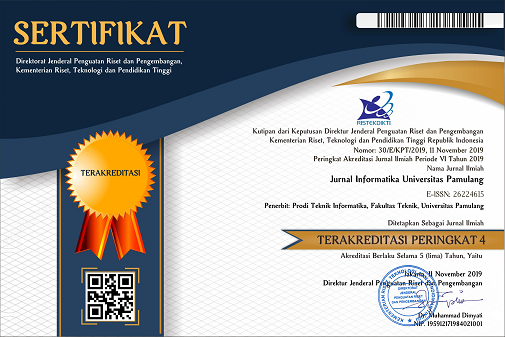Penerapan Algoritma K-Means Clustering untuk Menganalisis Penjualan pada Toko Ayu Collection Barbasis Web
DOI:
https://doi.org/10.32493/informatika.v6i3.12380Keywords:
Sales Analysis, K-Means Clustering, Website, Data MiningAbstract
The main activity in business is to determine the amount of stock that must be maintained to analyze the profit of each item sold. Therefore, groups such as high and low sales categories are needed to consider the stock of goods in the sales process. Ayu Collection store is a store that sells various types of clothing and accessories that have not implemented the grouping of goods in its sales information system to provide the maximum and the minimum number of stock items to be sold at the store. The process of grouping goods is still done manually, which is based on observations from shop owners. Therefore, to maintain the stock of goods so that no items are empty, this study aims to support the process of determining the stock of goods by building a model that can group items into high and low categories in sales using k-means clustering. The group with the highest centroid will be the group with the highest selling rate, while the lowest centroid will be the group with the least demand in sales. The data used in this study was taken from sales data in 2017 and 2018. The clustering scenario uses the variable name of goods, data of incoming goods, data of goods out, and stock of goods. The results of this study are showing the value of system performance in grouping goods by 83.33%.References
Devi, C., Soleman, O., Pramaita, N., & Sudarma, M. (2020). Classification Of Loyality Customer Using K-Means Clustering , Studi Case : PT . Sucofindo ( Persero ). 5(2).
Dr. Sandu Siyoto, SKM, M.Kes, M. Ali Sodik, M. (2015). Buku Metode Penelitian Kualitatif dan Kuantitatif.
Dwitri, N., Tampubolon, J. A., Prayoga, S., Zer, F. I. R. ., & Hartama, D. (2020). Penerapan Algoritma K-Means Dalam Menentukan Tingkat Penyebaran Pandemi Covid-19 Di Indonesia. JurTI (Jurnal Teknologi Informasi), 4(1), 128–132. Retrieved from http://jurnal.una.ac.id/index.php/jurti/article/view/1266
Hasanah, H. (2017). TEKNIK-TEKNIK OBSERVASI (Sebuah Alternatif Metode Pengumpulan Data Kualitatif Ilmu-ilmu Sosial). At-Taqaddum, 8(1), 21. https://doi.org/10.21580/at.v8i1.1163
Hastanti, R. P. (2011). Analisis Dan Perancangan Sistem Penjualan Berbasis Web ( E-Commerce ). 1–8.
Hernandhi, D. T., Astuti, E. S., & Priambada, S. (2018). Desain Sistem Informasi Pemasaran Berbasis Website Untuk Promosi ( Studi Kasus pada Kedai Ayam Geprak & Sambal Bawang Malang ). Jurnal Administrasi Bisnis, 55(1), 1–10.
Mirzaqon, A. T., & Purwoko, B. (2017). Studi Kepustakaan Mengenai Landasan Teori Dan Praktik Konseling Expressive Writing Library. Jurnal BK UNESA, 1–8.
Nawang, M., Kurniawati, L., Duta, D., Akuntansi, K., Informasi, S., & Akuntansi, K. (2017). Rancang Bangun Sistem Informasi Pengolahan Data Persediaan Barang Berbasis Dekstop Dengan Model. 13(2), 233–238.
Oktarina, C., Notodiputro, K. A., & Indahwati, I. (2020). Comparison of K-Means Clustering Method and K-Medoids on Twitter Data. Indonesian Journal of Statistics and Its Applications, 4(1), 189–202. https://doi.org/10.29244/ijsa.v4i1.599
Siregar, M. H. (2018). Data Mining Klasterisasi Penjualan Alat-Alat Bangunan Menggunakan Metode K-Means (Studi Kasus Di Toko Adi Bangunan). Jurnal Teknologi Dan Open Source, 1(2), 83–91. https://doi.org/10.36378/jtos.v1i2.24
Supardi, R., & Kanedi, I. (2020). Implementasi Metode Algoritma K-Means Clustering pada Toko Eidelweis. JurTI (Jurnal Teknologi Informasi), 4(2), 270–277. Retrieved from http://jurnal.una.ac.id/index.php/jurti/article/view/1444
Sutejo, B. S. (2006). Internet Marketing : Konsep Dan. Jurnal Manajemen, 6(1), 41–57.
Taufani, M., Riyadi, R., & Dewantara, R. (2016). Analisis Dan Desain Sistem Informasi Pemasaran (Studi pada Sistem Informasi Pemasaran untuk Promosi CV. Intan Catering). Jurnal Administrasi Bisnis S1 Universitas Brawijaya, 38(2), 1–10.
Downloads
Published
Issue
Section
License
Authors who publish with this journal agree to the following terms:
- Authors retain copyright and grant the journal right of first publication with the work simultaneously licensed under a Creative Commons Attribution-NonCommercial 4.0 International (CC BY-NC 4.0) that allows others to share the work with an acknowledgement of the work's authorship and initial publication in this journal.
- Authors are able to enter into separate, additional contractual arrangements for the non-exclusive distribution of the journal's published version of the work (e.g., post it to an institutional repository or publish it in a book), with an acknowledgement of its initial publication in this journal.
- Authors are permitted and encouraged to post their work online (e.g., in institutional repositories or on their website) prior to and during the submission process, as it can lead to productive exchanges, as well as earlier and greater citation of published work (See The Effect of Open Access).
Jurnal Informatika Universitas Pamulang have CC-BY-NC or an equivalent license as the optimal license for the publication, distribution, use, and reuse of scholarly work.
In developing strategy and setting priorities, Jurnal Informatika Universitas Pamulang recognize that free access is better than priced access, libre access is better than free access, and libre under CC-BY-NC or the equivalent is better than libre under more restrictive open licenses. We should achieve what we can when we can. We should not delay achieving free in order to achieve libre, and we should not stop with free when we can achieve libre.
Jurnal Informatika Universitas Pamulang is licensed under a Creative Commons Attribution-NonCommercial 4.0 International (CC BY-NC 4.0)
YOU ARE FREE TO:
- Share : copy and redistribute the material in any medium or format
- Adapt : remix, transform, and build upon the material for any purpose, even commercially.
- The licensor cannot revoke these freedoms as long as you follow the license terms





